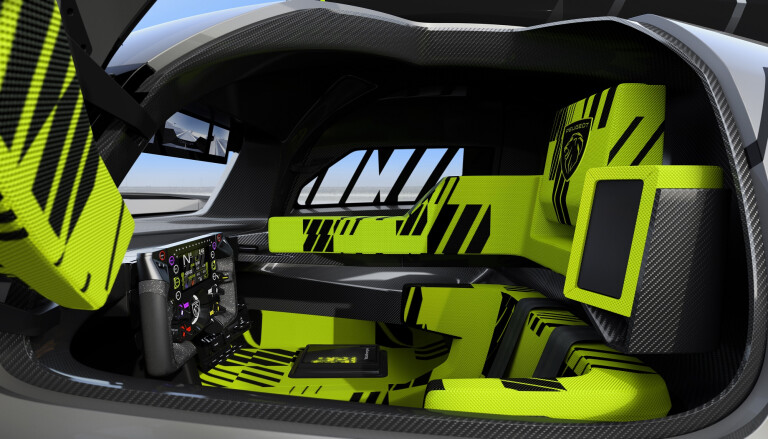
Get ready to wind back the clock. The prototype glory days are about to be reignited at La Sarthe.
In recent years it’s been a Toyota procession with the Japanese giant going up against privateer entries. However, that will all change with the FIA amalgamating the already established Le Mans Daytona Hybrid (LMDh) category with the burgeoning Le Mans Hypercar (LMH) class.
Once again endurance racing is back in favour with Peugeot, Ferrari, Toyota, Scuderia Cameron Glickenhaus and ByKolles committing to the new Hypercar class. Set to join them on the same grid is Porsche, Audi and BMW under the new LMDh regulations with Acura, Mazda, McLaren and Lexus all in various stages of deliberations.

Peugeot is the latest manufacturer to rip the covers off its racer, the 9X8, with its twin-turbo V6 hybrid set to tear up racetracks in time for the 2022 endurance season. And as you can see, it’s pretty wild, with trick aerodynamic technology paving the way for a wingless LMH offering.
But hang on, we bet you’re wondering how this mash-up will work. Making sure parity is under control will be FIA-designated ‘performance windows’ to which both categories must comply, along with general Balance of Performance (BoP) metrics. Think GT3 and how it deals with parity and you’re on the money.
Once again endurance racing is back in favour with Peugeot, Ferrari, Toyota, Scuderia Cameron Glickenhaus and ByKolles committing to the new Hypercar class.

We won’t blame you if that all seems as clear as mud. Essentially, combined system power is now limited to 500kW to lower costs, while cars must weigh no less than 1030kg. How manufacturers racing in LMH achieve the power figure is largely fair game, as the Hypercar class does not require electric motors.
If it is chosen, total electric assistance must not exceed 200kW. That extra zap also isn’t allowed to kick in below 120km/h and must only power the front axle – and only with dry-weather tyres fitted.
A ‘spec’ electric motor supplied by Bosch is available for LMDh teams, while Williams Advanced Engineering is also offering a plug-and-play hybrid powertrain for teams not wishing to develop their own.

Those opting for the LMDh route will choose from four accredited chassis suppliers: ORECA, Ligier, Multimatic and Dallara (whereas LMH chassis will be developed in-house). From there, basic bespoke bodywork from each manufacturer will wrap around the control chassis. However, there will be one general LMDh aerodynamic package available, and the sole tyre supplier is Michelin.
For both, complicated suspension set-ups make way for a more conventional double-wishbone design sans mass dampers and active systems. The gearbox is kilo-controlled at 75kg and a magnesium or aluminium casing is compulsory.
Essentially, combined system power is now limited to 500kW to lower costs, while cars must weigh no less than 1030kg.

Getting the cars right is now more important than ever, because once BoP has been met, the respective designs will be locked in for five years as a cost-containment measure. The prospect of a longer shelf life and projected savings in development is a key part of the attraction for car companies to once again go prototype racing.
So does this all mean we’ll see a return of the road-legal homologation special? Sadly not. It seems the governing bodies have gone cold on the requirement to produce 20 road-going versions of the winged prototypes, meaning a modern-day Porsche 911 GT1 straßenversion is unlikely. Toyota is going ahead with its GR Super Sport, however Aston Martin’s Valkyrie is now slated for
the road only; not the track.
While LMH cars are in the works for this year and next, 2023 is shaping up as the year both categories will fully align with big fields full of manufacturer support at La Sarthe. It’s shaping up to be an epic 100th birthday for the 24 hours of Le Mans and it will be essential viewing. At long last, prototype racing has well and truly regained its mojo.
Peugeot 9X8 - Three Key Points

Hybrid Grunt
Providing the internal-combustion grunt is a 90-degree 2.6-litre twin-turbo petrol V6 – dubbed HYBRID4 500KW. The front-mounted, high-density battery is being developed by Peugeot Sport and Saft

Drive us Crazy
The ‘X’ in the 9X8 name stands for all-wheel drive. The boosted V6 turns all fours via a seven-speed dual-clutch, while the high-voltage (900 volts) battery powers the electric motor on the front axle at more than 120km/h

Gone with the Wind
Fellas, where’s the rear wing? The 9X8 uses sophisticated aerodynamic tech that channels air underneath the car (think Nismo GT-R LM), negating the need for a drag-inducing wing. It should be an absolute weapon down the Mulsanne straight

COMMENTS